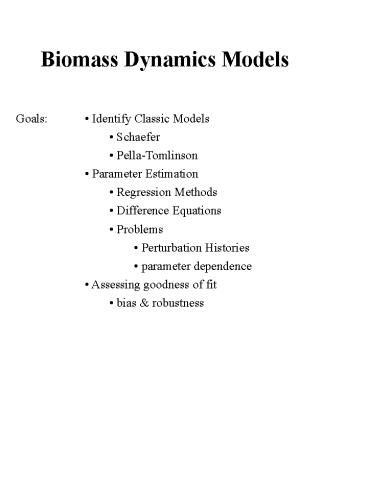Biomass Dynamics Models - PowerPoint PPT Presentation
1 / 16
Title:
Biomass Dynamics Models
Description:
Goals: Identify Classic Models. Schaefer. Pella-Tomlinson ... Pella and Tomlinson. m = 2 Schaefer. m 2 skewed left. m 2 skewed right. Biomass. Surplus ... – PowerPoint PPT presentation
Number of Views:346
Avg rating:1.0/5.0
Title: Biomass Dynamics Models
1
Biomass Dynamics Models
Goals
- Identify Classic Models
- Schaefer
- Pella-Tomlinson
- Parameter Estimation
- Regression Methods
- Difference Equations
- Problems
- Perturbation Histories
- parameter dependence
- Assessing goodness of fit
- bias robustness
2
Overview
- A.K.A. Surplus Production Models
- simple (3 or 4 parameters)
- no age structure
- no time lag
- no immigration/emmigration
- Useful when
- age structure is unavailable
- age related parameters are poorly known
3
The Basic Concept
Bt1 Bt Rt Gt - Mt - Ct
B stock size R recruitment G growth M
natural mortality C catch (fishing mortality)
production R G surplus R G - M Bt1
Bt surplus - Ct surplus Bt1 - Bt Ct
4
- peaks at intermediate biomass
- use actual stock size if available
- commonly, only index of abundance available
5
Schaefer
dB/dt rB(1 - B/K) -C C qEB
r intrinsic rate of population growth K
carrying capacity B biomass E effort q
catchability
- Variables C, E, B
- Parameters r, k, q
- surplus maximum at K/2
- MSY rK/4, EMSY r/2q
6
Pella and Tomlinson
dB/dt rB - rBm/K -C C qEB
- Parameters r, k, q, and m (shape)
- MSY peak is moved by m
7
Difference Equation Forms
- similar properties at low r values
- potential chaotic behavior at large r values
8
Parameter Estimation
I. Equilibrium Methods
- assume dynamics always at equilibrium
- Catch and Surplus at equilibrium
- dB/dt surplus - catch 0
dB/dt 0 rB(1 - B/K) -qEB
- have historical B index, E
- estimate r, k, q, MSY, etc.
- tends to overestimate production Why?
JUST SAY NO!
9
II. Regression Methods
- based upon assumed disequilibrium
- rearrangement of Schaefer model into
regression form - Walters Hilborn 1976, Schnute 1977
Bt1 Bt rBt(1-Bt/K) - q BtEt Bt Ut/q
where Ut C/E Ut1/Ut - 1 r - Ut r/kq - qEt
Yt b0 b1 Ut b2 Et
10
III. Time Series Fitting
- Variables C, E, U (C/E)
- Parameters r, k, q and B0
- Fit parameters according to (observed -
predicted) time series - U or C can be used
- choice of fitting criteria
- explicit error
- numerical methods required
- C.I. possible by computer intensive methods
- Note at least one more another parameter is
estimated (error)
11
Perturbation Histories
Yt Ut1/Ut - 1
low CPUElow effort
Ut
high CPUElow effort
Et
low CPUEhigh effort
- different possible histories
- initial high U, low E (over exploitation)
- recoveries (low E, U initially)
- need CONTRAST to estimate regression
parameters - odd error assumptions and C.I. s for biomass
dynamics models
12
PerturbationHistories
Ut1/Ut - 1
Ut
Et
- The one way trip
- exploited to low abundance
- unknown starting point
- little information for management
- Up and Down the Isocline
- increased, then decreased E
- gradual changes
- CPUE correlated with E
- best case, MSY estimated
- cannot distinguish between
- large, low productive
- small, highly productive
- NEED CONTRAST
13
- Estimate r
- low U and low E
- Estimate kq
- high U and low E
- Estimate q
- high E
Ideal Data Rare
MSY rk/4 r/qkq1/4
14
Examining Perturbation HistoriesBy Monte Carlo
Simulation
- Do not know true values in real data
- create a model system
- study the performance of estimators
- controlled numerical conditions
- Generate data from Schaefer Model
- set parameters
- Estimate parameters from new data
- use regression method
r k q MSY True .40 1,000 0.010
100 one way trip .13 290,000 0.003 9245 up
down .39 38,000 0.009 3705 Contrast .47
1,142 0.013 134
15
Assessing Goodness of Fit
- R2 of model
- predicted vs observed
- misleading, high R2 in equilibrium fits!!!
- You should always consider fit relative to
ALTERNATIVE models - Also consider parameter bias in the evaluation of
model performance - estimators from regression models known to behave
poorly - examine via Monte Carlo
16
Auxiliary Information































